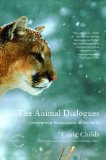What's the best nature-oriented book you read this year? Leave us a comment!
 Where the Wild Things Were: Life, Death, and Ecological Wreckage in a Land of Vanishing Predators
Where the Wild Things Were: Life, Death, and Ecological Wreckage in a Land of Vanishing Predatorsby William Stolzenburg (paperback, 304 pages)
Stolzenburg examines the critical role of predators in this highly-praised book. Predators are "keystone species" essential to biodiversity, and disasters can happen when they are removed from an ecosystem. Included among the examples in this book are the prolific white-tailed deer of Eastern forests, who are stripping undergrowth and destroying flora in our area because there are no longer wolves and cougars to keep them in check.
 The Animal Dialogues: Uncommon Encounters in the Wild
The Animal Dialogues: Uncommon Encounters in the Wildby Craig Childs (paperback, 352 pages)
In this book of first-person essays, Childs tells of his many encounters with animals, from mountain lions and grizzly bears to hummingbirds and red-spotted toads. Publisher's Weekly calls the essays "hauntingly beautiful": "Seeking entrée into animal societies, he interprets messages left in marks on the ground and in scents on leaves and trees, and communicates with animals directly using their own language of stares, gestures, postures, sounds, scents and gaits."
 Built by Animals: The Natural History of Animal Architecture
Built by Animals: The Natural History of Animal Architectureby Mike Hansell (paperback, 280 pages)
This book explores the complex structures that animals build, including bird nests, butterfly pupae, caddis larvae traps, beaver dams, and more. Hansell asks, how do creatures with such small brains achieve these impressive feats of engineering? The answers are explored through the results of scientific investigations on social structures, the biochemistry and mechanics of materials, and the impact of these structures on the larger ecosystem.
 One Square Inch of Silence: One Man's Search for Natural Silence in a Noisy World
One Square Inch of Silence: One Man's Search for Natural Silence in a Noisy Worldby Gordon Hempton and John Grossman (hardcover, 368 pages)
This book chronicles Hempton's travels from Seattle to Washington, D.C., in an attempt to find natural silence: a spot with "no audible human noise intrusions of any kind for a minimum of 15 minutes." Along the way, he discusses topics such as the decline in songbird populations, the effects of noise stress on both animals and humans, and the basics of audio science. He argues: "If a loud noise... can affect many square miles, then a natural place, if maintained in a 100 percent noise-free condition, will likewise affect many square miles around it.".
 American Earth: Environmental Writing Since Thoreau
American Earth: Environmental Writing Since ThoreauEd. by Bill McKibben (hardcover, 900 pages)
In his introduction to this anthology, McKibben argues that "environmental writing is America's most distinctive contribution to the world's literature." He goes on to present the work of 101 American writers chronologically, from Henry David Thoreau and John Muir to contemporary writers including Terry Tempest Williams, Barbara Kingsolver, Michael Pollan, and Paul Hawken. At 900 pages, there's a lot to chew on here.
 Dawn Light: Dancing with Cranes and Other Ways to Start the Day
Dawn Light: Dancing with Cranes and Other Ways to Start the Dayby Diane Ackerman (hardcover, 256 pages)
Ackerman launches each essay in this collection with the fresh start of a sunrise and launches into explorations of nature, mythology, and life -- especially life, and the need to live in the moment. A review in the Washington Post called it "glorious prose, studded with arresting phrases and breathtakingly beautiful images," with "sections that employ the precision of a naturalist and scientist to convey the wonder of a poet."
 Paradise Found: Nature in America at the Time of Discovery
Paradise Found: Nature in America at the Time of Discoveryby Steve Nicholls (hardcover, 536 pages)
"We have diminished nature far more than most people know." writes Nicholls. In a book he refers to as a "time machine," he sets out to describe just how abundant the natural world was in America before European settlement. From vast herds of buffalo, to flocks of carrier pigeons that blackened the sky, to fish so thick in the water that observers said they could have crossed a river without touching bottom, Nicholls draws on the accounts of explorers and settlers to document all that has been lost since those early Europeans first arrived.
If you're looking to read these books yourself, consider conserving resources by checking your local library for a copy. If you're gift shopping, we'll get a small percentage of the purchase price if you purchase from Amazon through one of the links in this post.


